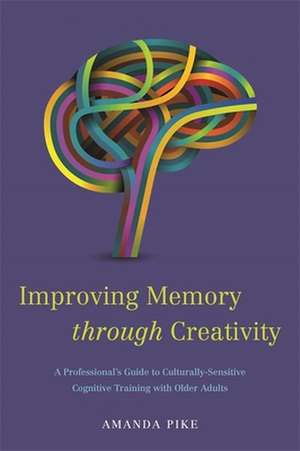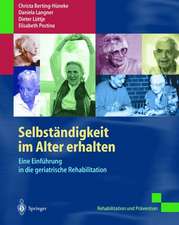Improving Memory Through Creativity
Autor Amanda Pikeen Limba Engleză Paperback – 14 feb 2014
Preț: 156.41 lei
Preț vechi: 164.64 lei
-5% Nou
Puncte Express: 235
Preț estimativ în valută:
29.93€ • 31.13$ • 24.71£
29.93€ • 31.13$ • 24.71£
Carte disponibilă
Livrare economică 24 martie-07 aprilie
Preluare comenzi: 021 569.72.76
Specificații
ISBN-13: 9781849059534
ISBN-10: 1849059535
Pagini: 192
Ilustrații: 19 b+w figures
Dimensiuni: 150 x 227 x 10 mm
Greutate: 0.27 kg
Editura: Jessica Kingsley Publishers Ltd
ISBN-10: 1849059535
Pagini: 192
Ilustrații: 19 b+w figures
Dimensiuni: 150 x 227 x 10 mm
Greutate: 0.27 kg
Editura: Jessica Kingsley Publishers Ltd
Notă biografică
Amanda Pike has taught internationally on themes related to creative art therapies. She has a Master's degree in Creative Arts Therapy from Nazareth College and a Ph.D. specialising in Art Therapy from Florida State University. Her doctoral research evaluated art therapy as a means of cognitive training and the results demonstrated enhanced cognitive performance among culturally diverse older adults. Currently, Amanda is serving as President of the Florida Art Therapy Association and works as a registered art therapist. She lives in Miami, Florida where she applies her work with clients across the life-span. In addition to clinical work, Amanda provides outcome study consultations and welcomes opportunities for collaboration.
Cuprins
1. Late-Life Creative Self-Expression and Memory. 1.1. How-to-Apply Information Presented within this Text. 1.2. Normal and Abnormal Aging. 1.3. Alzheimer's disease. 1.4. Risk Factors of Memory Loss. 1.5. Mental Stimulation. 1.6. Stress. 1.7. Emotional Stress and Social Isolation. 1.8. Self-Expression in Late-Life. 1.9. Encouraging Mental Stimulation through Expressive Art-Making. 1.10. Incorporating Creativity into Older Adult Identity through Art-Making. 1.11. Creative Behavior. 1.12. Creative Thought. 1.13. Creative Self-Expression. 1.14. Summary. 2. Happiness, Social Creativity, and the Brain. 2.1. Happiness and Creative Self-Expression. 2.2. Elevating Mood during Creative Sessions. 2.3. Bodily/Sensory Pleasures. 2.4. Higher Order Pleasures. 2.5. Gratifications. 2.6. Happiness, Creativity and the Brain. 2.7. Neurotransmitters and Creativity. 2.8. Making Art that Expresses and Enhances Mood. 2.9. Visual Elements, Cognition and Mood. 2.10. Combining Visual Elements for Enhanced Mood. 2.11. Social Equality vs. Stratifications during Creativity and Happiness. 2.12. Summary. 3. Culture, Communication and Art. 3.1. Promoting Socialization during Memory Training. 3.2. Culture. 3.3. Providing Cultural Neutrality. 3.4. Communication. 3.5. Art in Communication. 3.6. Visual Literacy. 3.7. Social Sharing of Meaning through Art. 3.8. Social Roles. 3.9. Increased Socialization through Art. 3.10. Summary. 4. Cognitive Training through Creative Self-Expression. 4.1. Addressing Cognitive Abilities. 4.2 Emotion-Focused Interventions. 4.3. Targeting Cognitive Performance through Creativity. 4.4. Nature of Cognitive Impairment. 4.5. Type of Memory Impacted. 4.6. Short-term Working Memory vs Long-term Memory. 4.7. Cognitive Training. 4.8. Restorative Strategies. 4.9. Compensatory Strategies. 4.10. Expressivity-based Memory Techniques. 4.11. Neurobiology of Creativity and Expressivity. 4.12. Theory: Going Beyond "Recipes". 4.13. Understanding Cerebral Activity in Art-Making. 4.14. Examples of artwork and corresponding ETC. 4.15. Educational vs Therapeutic Frameworks. 4.16. Summary. 5. Understanding Art to Understand the Mind. 5.1. Elements of Successful Sessions. 5.2. Additional Planning for Effective Sessions. 5.3. Rhythmic Structure and Versatility in Directives. 5.3. Outline of Ten-Weeks of Sessions. 5.4. A Single Directive for All Ten-Weeks. 5.5 Concluding the Ten Weeks. 5.6. Summary. 6. Going beyond the Book: Community Collaborations. 6.1. Scope-of-Practice. 6.2. Cultural Trends in Seeking Care. 6.3. Caregivers. 6.4. Inter-Generational Projects. 6.5. Services/Systems of Care across Settings. 6.6. Getting Started. 6.7. Identifying Symptoms Cross-Culturally. 6.8. Organizations. 6.9. Ways to Continue Learning. 6.10. Summary. 6.11. Learning Evaluation Quiz. References.



















